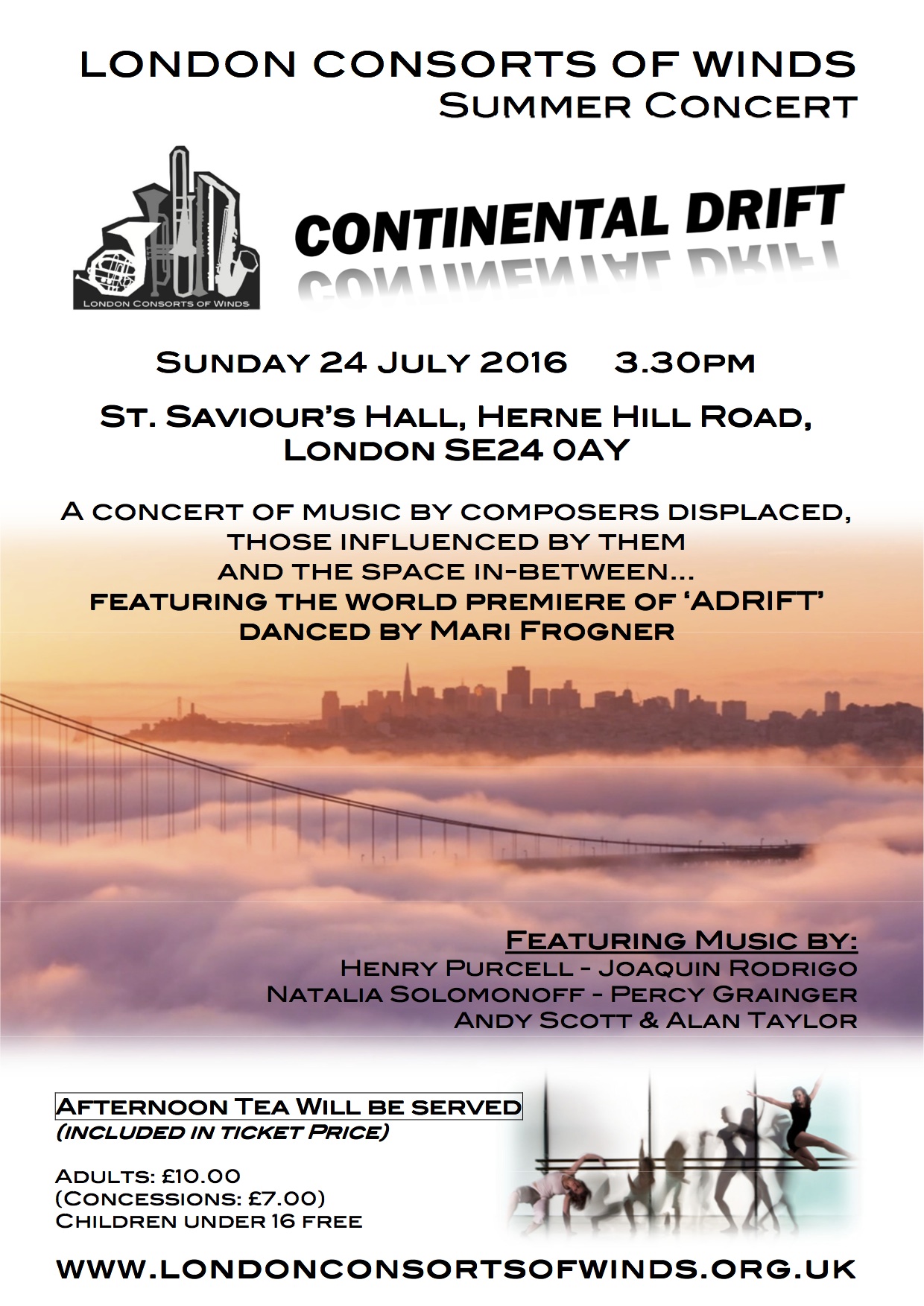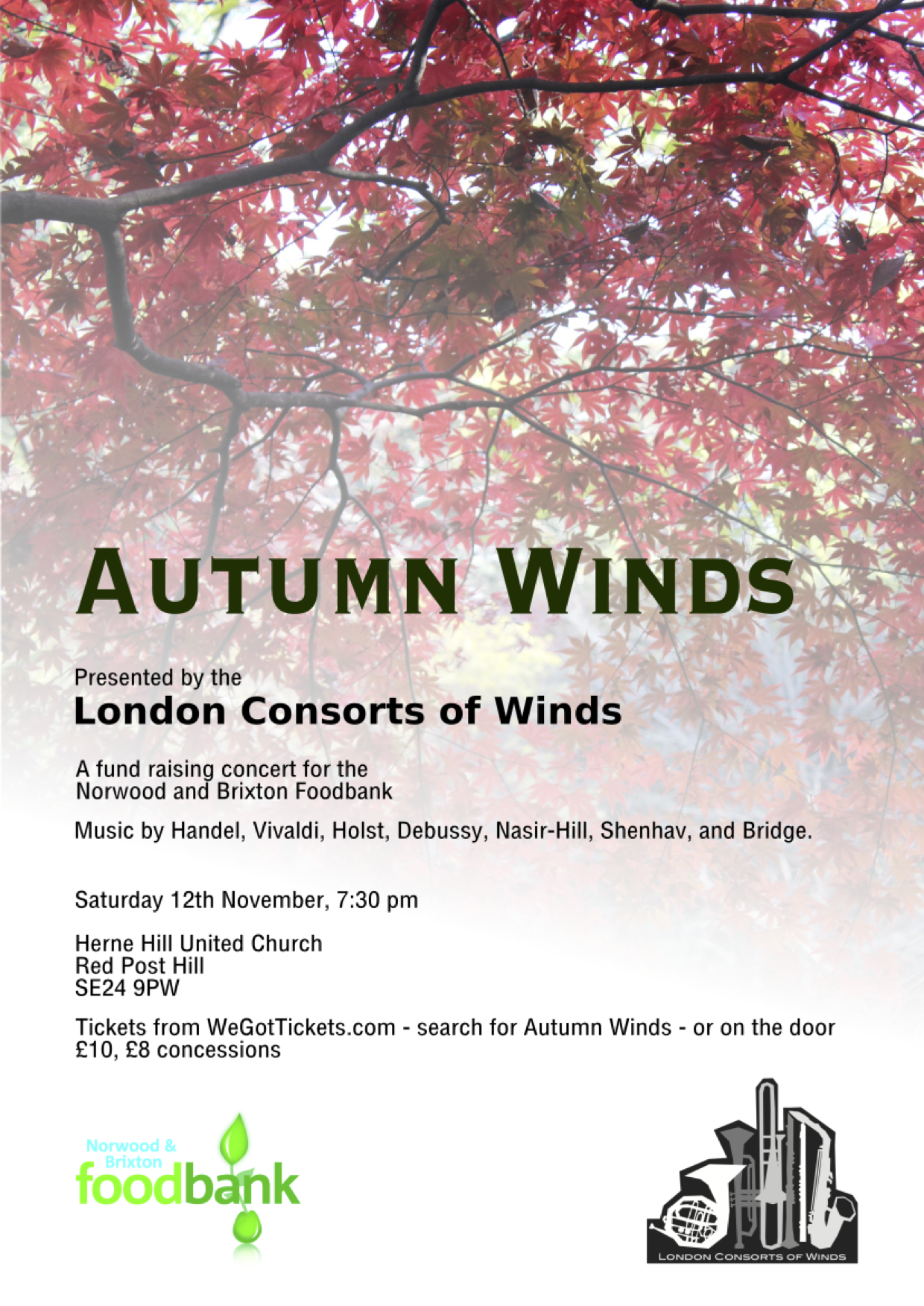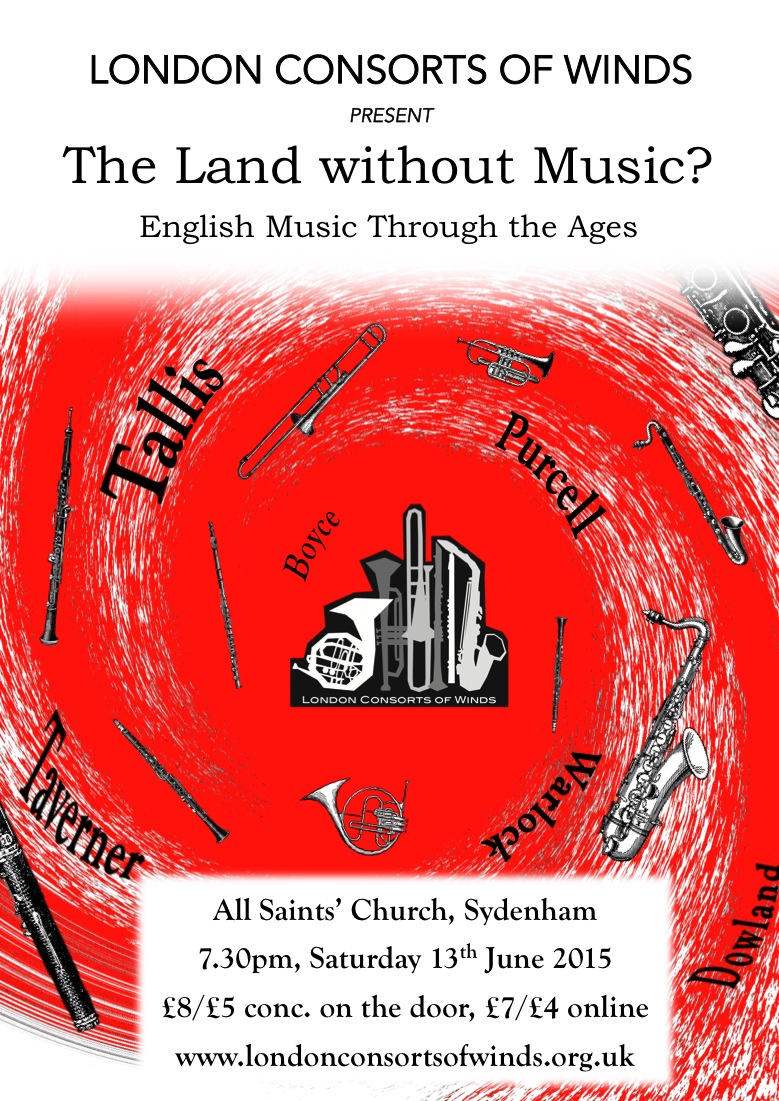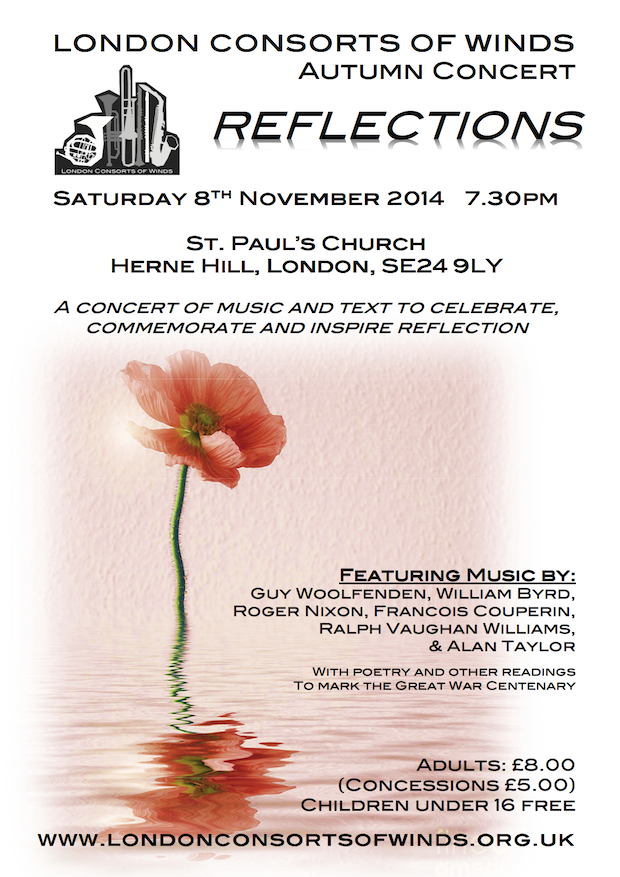Our 2016 autumn concert was on 12th November at Herne Hill United Church, with the theme “Autumn Winds”. The music included pieces by Palestrina, Handel, Vivaldi, and many others. The concert raised money for the Brixton and West Norwood Food Bank.
Our 2016 summer concert was on 24th July at St Saviour’s Church Hall (Herne Hill Road, SE24 0AY) and had the theme “Continental Drift”.

Our formal concert on 7th November 2015 at St. Leonard’s Church, Streatham had the theme “An ABC of Music” and all the composers surnames began with A, B or C.
On 13th June 2015 at 7.30pm we performed our summer concert in All Saints’ Church, Sydenham.
Our 2014 autumn concert was on Saturday 8th November 2014 at St. Paul’s Church, Herne Hill, SE24 9LY. The theme of the concert was ‘Reflections’ and it included music, poetry and readings that reflected on the outbreak of war in 1914. The music included pieces composed by Guy Woolfenden, William Byrd, Roger Nixon, Francois Couperin, Ralph Vaughan Williams and Alan Taylor.
Saturday 14th June 2014, All Saints Church, Trewsbury Road, Sydenham
This particularly strangely-titled march was written for piano, also in London, in 1872 and orchestrated seven years later. We are probably familiar with it as the signature tune for Alfred Hitchcock’s television series of crime thrillers.
Saturday 10th November 2012, St. Gabriel’s Church, Warwick Square, London SW1V 2AD
Sunday 10th October, St. Hilda's Church, Crofton Park
Saturday 14th November, St Faith's Church, Red Post Hill, SE24
2. Dance. Trio: Satyrs and Nymphs
3. Night and Phantoms
4. Morning song. Dance
5. Together – art by all musicians
The opening movement is a jolly Allegretto with a flowing melody interspersed through the ensemble. The sweet ending fades us into the second movement, marked Allegro non tanto (not so much) in a waltz-like feel. The Satyrs and Nymphs bound gracefully through dotted-rhythm motifs and triplets, with some punctuation by short, sharp notes.
Night and Phantoms starts solemnly, in the clarinet and bassoon, with sighs from the other instruments. At the Allegro Vivace, we pick up the tempo and listen to ghosts and ghouls emerging from the darkness. After the night comes the Morning song, at a walking pace the sweet clarinet and oboe sound the initial melody. The dance that follows in a canon style is reminiscent of a lederhosen-slapping affair, with all instruments having a turn at the melody.
Saturday 13th June, St Faith's Church, Red Post Hill, SE24
Return to the top of the page
The French term divertissement (divertimento in Italian) was frequently used in the 18th and 19th century to identify an instrumental composition written in a light vein and used primarily for entertainment. The title was given to an enormous variety of music written for chamber ensembles consisting of three to eight or more players. Closely related types are the serenade, cassation, and nocturne. Over the years the divertimento has evolved into many different styles and forms.Emile Bernard’s Divertissement, for example, is an outstanding three-movement wind symphony in a late Romantic style. Bernard, a French organist and composer, studied at the Paris Conservatory and later in his career was organist of the church of Notre-Dame des Champs in Paris from 1887 to 1895. Bernard was not a prolific composer. However, his serious and reflective disposition is shown in almost all of his works, including the Divertissement. Composed around 1894 for wind dectet and first performed by the Parisian Societe des Instruments a Vent. There are three movements:Andante sostenuto – Allegro molto moderato
Allegro vivace
Andante – Allegro non troppo
Note by Robert J. Garofalo
Saturday 11th October, St Cyprian's Church, Glentworth St, Marylebone, NW1
Based on the music of the Banda-Linda people of ZaireBanda-Linda traditional horn music uses a large orchestra of tuned animal horns each of which is capable of playing only two notes. My piece is organised around a traditional melody that weaves its way between the instruments. The other instruments play melodic fragments around it in such a way that a very complex texture is generated. Since the melody itself is fragmented it becomes imperceptible to anyone who does not know it is there.Complex music in oral traditions can normally be broken down into conceptually simple ideas, which I call “modes”. These cover not only concepts such as pitch, rhythm, and polyphony but also notions that are foreign to “western music” such as the time of day a piece can be played or whether drinking beer is allowed in the performance. My interest derives not from a wish to “Europeanise” such music, as, for instance, so-called “World Music” does, but from a wish to explore non-European compositional techniques. This piece is mainly based on the “modes” used in Banda-Linda horn music, but also contains traditional xylophone melodies and “talking” drum rhythms.
Saturday 12th July, All Saints Church, Lovelace Road, West Dulwich
Charles Gounod wrote his “Petite Symphonie” in 1885 for the Parisian wind ensemble “La Trompette” which was directed by the celebrated flautist Paul Taffanel. This may possibly explain why there is no second flute part in the original scoring. What is less understandable is the dearth of notes in the original second oboe part and the version performed tonight will feature both a newly-created second flute and a more rounded second oboe part.
Petite Symphonie has four movements: Adagio/Allegretto, Andante cantabile, Scherzo and Finale allegretto.
“I was commissioned to compose a piece for the Southwark Winds Ancient and Modern Consort in the summer of 2004 and looked forward to the challenge of writing for this unusual combination of instruments. I was particularly interested in how the ensemble could be grouped into blocks of sound using different combinations, in particular the woodwind versus brass with the alto saxophone taking an independent lyrical role in the middle. The work was partly built around this and the tutti ensemble is not heard until over halfway through the piece.I began writing Turnabout at the beginning of 2005 shortly after starting my PhD studies in composition at Cardiff University, having just finished teaching A level music. Bach Chorales were much on my mind as I had taught them for several years and I was aware of how they had epitomized Western harmony for several centuries. I thought it would be fun and interesting to include a contemporary version of a chorale, almost to get them out of my system! In fact, I included two, both closely related to each other and they are at the heart of this work.There is also a waltz – although you couldn’t dance to it because of the irregular time signature. Later in the piece the two styles combine, and it is this contrast and development that inspired the title.”
Howard Jones won the the Community Music category in the ‘Composer of the Year Awards’ in 2007.
Soloist - Maya Sapone (soprano)In The Dark was composed in memory of the contemporary Persian poet Forough Farrokhzad (1935-1967), the most famous woman in the history of Persian literature. The piece is a dark and intense tone poem, which explores the sound world of both Persian and contemporary musical gestures.The composer writes: " In this work I returned to the poetry of Forough, which inspired so many of my recent compositions. The text is dark. The music is accordingly, somber and dramatic, demanding a lot of personal expression by the performer from abject despair in the opening to the bitter lyricism of the final part through the frustration in the middle episode."
Amir Tafreshipour was born in Iran in 1974 and studied at the Academy of Music in Esbjerg, Denmark where he gained his BMus in piano and pedagogy in 2001. In 2003 he gained a BMus in composition at Trinity College of Music in London, and in 2004 he gained an MA in composition at the Guildhall School of Music and Drama in London. He won several prizes during his studies.
Maya Sapone is an opera singer with a fascinating international background which embraces the culture of three continents: Africa, Europe and Asia. Born in Gabon to an Italian father and Thai mother, Maya furthered her singing studies in England, Spain and Italy.
Rimsky-Korsakov (1844-1908) was one of the Russian composers from the group known as “The Five”. The group met in St Petersburg and their aim was to produce specifically Russian art music, rather than music derived from the European conservatoire tradition. The other composers from the group were Balakirev, Cesar Cui, Modest Mussorgsky and Alexander Borodin.
The “Dance of the Buffoons”, also known as the “Dance of the Skomorokhi”, comes from the 3rd act of the opera “The Snow Maiden”. It consists of two main contrasting themes, one fast and staccato and the other lyrical, repeated and slightly varied.
Saturday 9th February, Herne Hill United Church, Red Post Hill, SE24
Gordon Jacob (1895-1984) was one of the most popular of British 20th century composers. During his lifetime he composed over 700 pieces of music and wrote several books. Some of his famous compositions are: “Divertimento” for small orchestra (1938) “Double Concerto for Clarinet, Trumpet and Strings” (1976) “Flute Concerto No. 2” (1981) and “Mini Concerto for Clarinet and Strings” (1980)”Wind in the Reeds” was comissioned by the British Federation of Music Festivals with financial assistance from the Yorkshire Arts Association and it is dedicated to the Federation, who gave its 1st performance at their Summer School in 1993 in Harrogate, Yorkshire. The piece consists of four short pieces:March
Humoreske
A Childhood Memory
Ballet Russe
This composition aims to depict something almost impossible to represent through the media of music: silence. Dizziness and Silence aims to create the sensation of time passing by while the mind loses its sense of stability and orientation within the music.The work has three movements, which despict in turn silence, then dizziness, and finally returning to silence. The first movement, despite its lack of pulse, is based on a repeating rhythmic subject, forwards, in reverse and both simultaneously. The concept of dizziness, in the second movement, is provided by faster figuration and constant use of trills. The last movement exploits Webernian pointillism which causes the harmony and the melody to float through the consort without providing intelligible phrases to any one instrument.The movements are joined together by a harmonic design derived from the first chord of the piece inverted and transposed creating a harmonic chain without apparent destination. Theatrical gestures such as emphasized breathing and percussive key movements add to the atmosphere.
Sunday 18th March, St Paul's Herne Hill
Paul Harvey’s baritone concertino was written for his friend David Lawrence, a soprano and baritone saxophone player in the London Saxophone Quartet – a group which Paul led on soprano saxophone for its 16 year existence (1969-85). Paul Harvey was born in 1935 in Sheffield, he subsequently studied clarinet and composition at the Royal College of Music in London. The majority of his career was spent as Professor of Clarinet at Kneller Hall, the Royal Military School during which time he wrote or arranged numerous pioneering works for clarinet and saxophone ensembles.The Concertino demonstrates the versatility of the baritone saxophone family often earmarked as the rhythmic driver of saxophone ensemble music. The one movement piece is divided by tempo into 3 thematic sections. The slower opening section, in 4/4 time, pays homage to the early classical genre of the concertino. A rich baroque-esque tutti from the accompanying clarinet choir introduces the lyrical capabilities of the solo instrument through a number of impressive cadenzas.The section gains momentum through an exciting accelerando leading us to the second section – light and dance-like, written in punchy 5/8 time. Harvey’s joyful theme resonates through all the clarinet parts and the soloist, resulting in several contrasting and melodic dialogues between the upper clarinets and the low baritone. The final section of concertino, written in 3/4, marries the classical genre with 20th century. After bold harmonies and frantic passages from the soloist the piece climaxes with an allargando.
Dvorak was born in 1841, the son of the local butcher and publican in Nelahozeves. His exceptional musical gifts were recognised, and he studied in Prague from the age of 16, soon earning his living in the Czech National Theatre Orchestra, under Smetana’s direction. Dvorak received the Austrian prize for composition and Brahms, one of the adjudicators, encouraged him and became a personal friend.He first visited England many times between 1884 and 1896. He spent three years (1892-1895) in the USA, as director of the new National Conservatory in New York. Back home, Dvorak then became director of the Prague Conservatoire.Dvorak’s Legends have the opus number 59 which places them early in the 1880s. The Legends are full of a warmth and mellowness that speaks of a composer enjoying his maturity. Like the Slavonic Dances, the Legends were originally for piano duo, and were orchestrated by Dvorak himself. Roger Cawkwell has arranged them for double wind quintet and double bass.
The Concerto Grosso form is built on the principle of contrasting two differently sized instrumental groups. In Corelli’s, the smaller group consists of two violins and a cello, and the larger of a string orchestra.
Of all his compositions it was upon his the 12 concertos of Opus 6 that Corelli labored most diligently and devotedly. Corelli spent many years of his life writing and rewriting this music, beginning while still in his twenties. We will be performing an arrangement of number 11.
Saturday 1st July, Christchurch, Gypsy Hill
Kyrie, Christe, Kyrie II
Josquin des Pres was recognisd as the leading composer of the early sixteenth century. His music draws on the Flemish and northern French traditions, and firmly established melodic imitation between the voices – heard clearly in the opening movement of the mass based on the plainchant Pange Lingua – as a fundamental method of constructing polyphonic music.
In aid of the Medical Foundation for the Care of Victims of Torture (Greenwich and Lewisham group)
Blackheath Friends Meeting House, Lawn Terrace, Blackheath
Saturday 18th March
Dvorak was born in 1841, the son of the local butcher and publican in Nelahozeves. His exceptional musical gifts were recognised, and he studied in Prague from the age of 16, soon earning his living in the Czech National Theatre Orchestra, under Smetana’s direction. Dvorak received the Austrian prize for composition and Brahms, one of the adjudicators, encouraged him and became a personal friend.He first visited England many times between 1884 and 1896. He spent three years (1892-1895) in the USA, as director of the new National Conservatory in New York. Back home, Dvorak then became director of the Prague Conservatoire.Dvorak’s Legends have the opus number 59 which places them early in the 1880s. The Legends are full of a warmth and mellowness that speaks of a composer enjoying his maturity. Like the Slavonic Dances, the Legends were originally for piano duo, and were orchestrated by Dvorak himself. Graeme Kay has arranged the Legends for double wind quintet with contra bassoon. He has used Dvorak’s own orchestration as a guide to tone colours.
Church of St. John the Divine,Upper Selsdon, Croydon, on
Saturday 2nd July
Scherzo, Nocturne, MarchIn 1927 Holst was commissioned to write a competition piece for the BBC and the National Brass Band Festival Committee. The result was The Moorside Suite. Here it is played in an arrangement for wind ensemble by Geoffrey Emerson.The suite has three movements, and upon a first listen, one hears a noticeable sophistication that was lacking in the military suites. The first movement seems almost reserved in its impact. The rhythm definitely darts about, but it doesn’t really go towards any harmonic climax. It leaves the listener almost trapped in an intellectual game of sorts. The second movement, the ‘Nocturne’ is written beautifully with its descending thirds and sixths. It is a warmth that Holst was just beginning to discover, perhaps only matched by ‘Love on thy heart’ from the Seven Partsongs for female choir, or the Lyric Movement. It almost seems like a mature response to ‘I love my love’. The last movement is reminiscent of the ‘Marching Song’ from Two Songs without Words.
Kyrie, Sanctus, Benedictus, Agnus Dei
William Byrd, as a Catholic in Elizabethan and early Jacobean England, had to watch his step. In spite of being established as the most prominent musician of his time, he was repeatedly fined for his religious beliefs. His religious music, consequently, has a private character, and in fact was written for performance in small ceremonies, almost in secret, in the houses of the Catholic nobility – a far cry from the sumptuous catherdral masses written by Italian composers during the same period.
I was commissioned to compose a piece for the Southwark Winds Ancient and Modern Consort in the summer of 2004 and looked forward to the challenge of writing for this unusual combination of instruments. I was particularly interested in how the ensemble could be grouped into blocks of sound using different combinations, in particular the woodwind versus brass with the alto saxophone taking an independent lyrical role in the middle. The work was partly built around this and the tutti ensemble is not heard until over halfway through the piece.I began writing Turnabout at the beginning of 2005 shortly after starting my PhD studies in composition at Cardiff University, having just finished teaching A level music. Bach Chorales were much on my mind as I had taught them for several years and I was aware of how they had epitomized Western harmony for several centuries. I thought it would be fun and interesting to include a contemporary version of a chorale, almost to get them out of my system! In fact, I included two, both closely related to each other and they are at the heart of this work.There is also a waltz – although you couldn’t dance to it because of the irregular time signature. Later in the piece the two styles combine, and it is this contrast and development that inspired the title.
Pergolesi was commissioned to write his Stabat Mater for a private ceremony for a group of the Neopolitan nobility. It replaced a work by Scarlatti, considered to be old-fashioned, but the new piece divided opinions, being hailed as a masterpiece and condemned as vulgar. It reflects a more directly personal form of religious devotion, and has a directness and power of emotional expression which may have seemed tasteless to people accustomed to more restrained music.
(i) Arietta(ii) Norwegian(iii) At the Cradle
These short, intimate pieces are three of Grieg’s many ‘Lyric Pieces’. They were originally written for the piano. Norwegian folk song is one source of inspiration for these pieces, and another are the many similar miniatures by such Romantic Movement composers as Schumann, Mendelssohn and Chopin.
New Music from Argentina and England
Conway Hall, Red Lion Square, London WC1
Wednesday 23rd February
If the players are seen as two quintets, the relationship between the two shifts from generally cooperative to generally antagonistic during the central section, and the resulting tension is not resolved.
St Barnabas Parish Hall
Dulwich Village, London SE22
Saturday 3rd July
Michael Ball was born in Manchester, and studied at the Royal College of Music, and also in Italy with Ligeti and Berio. This piece is characterised by extremely rhythmic writing, frequent changes of time signature and cross-rhythms. It was written for Berkshire Young Musician’s Trust, and first performed in 1998.
Wind consort and serenade music from the Renaissance to the modern day
St Nicholas Church, Sevenoaks
Saturday 12th July
The second movements opens with a beautiful oboe melody that could be an arioso out of an Italian opera. The bassoon enters and joins the oboe, to create an operatic soprano and baritone duet. This movement is in three part song form.
The minuet is a preview of the later Beethoven scherzo both rhythmically and melodically. The trio hosts a dialogue between the clarinet and horns in which the characteristic colour of these instruments is beautifully contrasted.
The final movement is very playful and energetic. The instrument sounds weave a colour texture with runs, arpeggios and syncopated chords. The second theme contains the outline of the Hymn of Joy.


